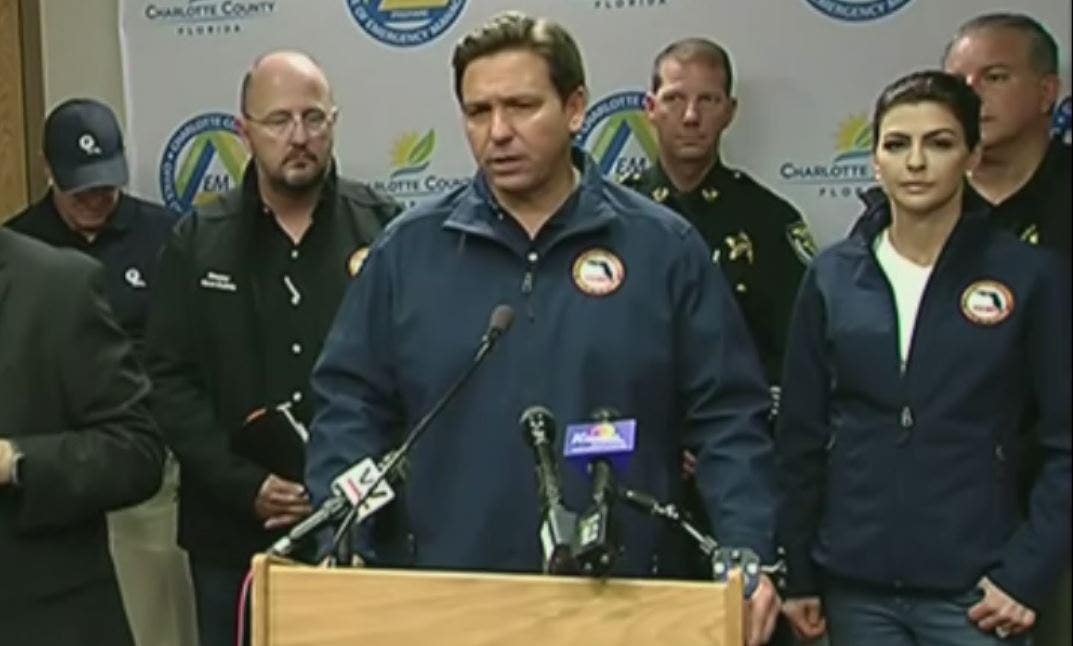A New York Times guest essay blasted Florida Governor Ron DeSantis’ strategy to protect Florida from massive storms like Hurricane Ian because it ignores how climate change works.
In the essay, author Craig Pittman argued that DeSantis, R-Fla., insisted on using taxpayer money to shore up Florida’s heavily developed areas in preparation for the storm instead of acknowledging that climate change’s threats to these areas means they should be abandoned, and its inhabitants move to other areas.
In addition, Pittman claimed DeSantis has done nothing about combating fossil fuel emissions which increase the heat in Florida, intensify storms and promote “toxic algae blooms.”
RON DESANTIS ON AFTERMATH OF HURRICANE IAN: WE’RE GETTING PEOPLE BACK ON THEIR FEET | FOX NEWS VIDEO

Fl. Gov. Ron DeSantis delivers a press briefing following Hurricane Ian.
Pittman began his piece by describing the level of destruction in Florida, writing, “Hurricane Ian didn’t just wreak havoc across Florida’s southwest coast. It also dumped so much rain inland that rivers across the state flooded… The floodwaters blocked highways, inundated cattle ranches and stranded hundreds of people.”
He mentioned how the “shiny white boots” DeSantis wore to survey the damage on inland parts of his state indicated just how inferior his plan to protect Florida was. Pittman wrote, “But by donning those wading boots, usually worn by fishermen on the coasts, Governor DeSantis exposed a truth he has avoided for the last four years: Climate change isn’t just happening along Florida’s edge.”
The author then slammed the governor’s refusal to acknowledge climate change, declaring, “When he was running to replace Gov. Rick Scott, a climate change denier, Mr. DeSantis sneered that he was ‘not in the pews of the church of the global warming leftists.’”
And to the disappointment of climate change advocates, DeSantis used “taxpayer money to protect the rampant development of low-lying areas such as Lee County — development that some of Governor DeSantis’s staunchest campaign contributors helped lead.”
POLL: DO FLORIDA VOTERS SUPPORT DESANTIS’ MIGRANT FLIGHTS?

October 1, 2022: Line workers spring into action in Lake Wales, Florida in response to Hurricane Ian.
(Fox News Photo/Joshua Comins)
Pittman wrote, “Hurricane Ian has revealed in brutal detail the inadequacy of his approach,” adding, “The sea walls, sewage pump stations, wastewater treatment plants and ‘living shorelines’ that taxpayers funded did little to help inland towns like Arcadia. Hundreds of Central Florida homes remain flooded two weeks on, as rivers flush out the heavy rain.”
He pointed out climate change’s effect on this flooding: “One study found that climate change may have added 10 percent to Ian’s rainfall.”
The piece hammered the DeSantis strategy, stating, “Protecting Florida from the effects of future storms like Ian calls for more than just resilience. It calls for carefully retreating from the rising water and rebuilding where it’s safe. But retreat has never been in Governor DeSantis’s plan.”
It added, “There has been little to no attempt by his administration to stop further development in vulnerable coastal areas.” The piece also claimed that DeSantis’ plan doesn’t actually solve the major issue. “Expensive resilience projects like the ones the governor has supported can only ever be a temporary fix. As the sea level rises, they will have to be replaced, made higher, built larger… They don’t address the cause of climate change, only the symptoms, and only for a little while.”
Pittman argued that the governor could get it right if he actually considers climate change’s effects. “If Governor DeSantis ever gets serious about a changing climate, the place to start is with the emissions that are also driving Florida’s other dangerous impacts.”

Residents use pumps to remove water from around their homes in the Battery as the effects from Hurricane Ian are felt, Friday, Sept. 30, 2022, in Charleston, S.C. (AP Photo/Alex Brandon)
He listed those impacts as “the intensifying heat waves that put outdoor workers at risk of dehydration and death, the warmer ocean waters causing rapid intensification of storms like Ian and the toxic algae blooms, which are also exacerbated by pollution.”
However, he claimed, “The governor has gone in the other direction. Rather than encouraging homes and businesses to switch to renewable energy or requiring any retreat from the growing risks of climate-fueled devastation, he has taken steps to protect the oil and gas industry spewing carbon dioxide into the atmosphere.”
Pittman concluded, saying, “If resilience, Florida style, goes national, we all may need some of those white boots.”









